Presidents 10 - 12
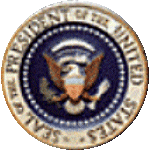

John Tyler
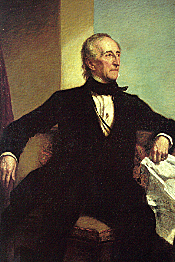
John Tyler was a man of strong, independent principles. Although he had been
elected to the Senate as an Andrew Jackson Democrat, he came to disagree with
many of President Jackson's policies, especially Jackson's attack on the Bank
of the United States. Resigning from Congress and the Democratic Party, Tyler
lost his political seat, but remained steadfast in his convictions.
John Tyler was born in Virginia not far from the boyhood home of his future
running mate, William Henry Harrison. His father had been governor of Virginia
and an admirer of Thomas Jefferson. Even as a young boy, Tyler began absorbing
his father's Jeffersonian notions concerning states' rights and strict
interpretation of the Constitution.
After graduating from William and Mary College at age 17, Tyler practiced law
and was elected to the Virginia legislature when he was only 21 years old. He
became a member of Congress and then governor of Virginia, but he resigned the
governorship when he was elected to the Senate. Although he had begun his
career as a Democrat, his opposition to Jackson and loss of the Senate seat
caused him to return to the Virginia House of Delegates as a Whig in 1838.
The Whigs chose Tyler as William Henry Harrison's running mate in 1840, hoping
that Tyler would attract southern votes. When Harrison died a month after his
inauguration, Tyler was sworn in as President. Many Whigs thought that Tyler
would merely be an "acting President" who would follow the former
Presidentís policies or act on the advice of the Cabinet. But Tyler soon
proved his will to be an independent President. He vetoed Congress's bill for
higher tariffs and for reestablishing a national bank. The Whig party bosses
were shocked and every Cabinet member except Secretary of State Daniel Webster
resigned.
John Tyler became a President without a party. Neither the Whigs nor Democrats
supported him, and his opponents called him "His Accidency."
With Congress united against him, there was little Tyler could accomplish.
After his term ended, Tyler returned to Sherwood Forest, his Virginia
plantation. In retirement, he served on a commission in 1861 seeking peace
between the North and the South. His most memorable act as President was to
sign bills admitting Florida and Texas into the Union.
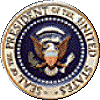
James Knox Polk
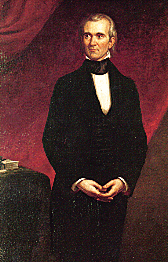
In 1845, President Polk rode into the White House on a wave of popular
support. Americans eagerly endorsed his promise to expand the United States
from sea to sea. Polk made good on his promise. No man -- except Thomas
Jefferson -- did more to expand the nation's boundaries. But to fulfill his
dream, he led the United States into a bloody war with Mexico.
James Knox Polk was born on November 2, 1795, in Mecklenburg County, North
Carolina. His family soon moved to Tennessee, where his father was one of the
state's most productive planters. After graduating from the University of
North Carolina in 1818, Polk became a lawyer and a Jacksonian Democrat. In
1825, he was elected to the first of seven consecutive terms in the House of
Representatives.
Polk earned a reputation as an intelligent and hard-working man, but one who
lacked charisma. Usually reserved and without a sense of humor, he was perhaps
more respected than liked. Although his colleagues in the House of
Representatives elected him Speaker in 1835, they also called him "Polk
the Plodder" behind his back.
In 1844, the Democratic Party selected Polk to run for President when party
leaders found they could not agree on any other candidate. Polk promised that
if elected, he would annex Texas and push American claims in the Oregon
territory. Expansion was a popular issue, and Polk beat Whig candidate Henry
Clay, who had wavered in his support for annexing Texas.
First, he moved to gain control of Oregon. Though both Britain and United
States claimed the Oregon territory, neither nation wanted to go to war. In
1846, Tyler agreed to a compromise, and the territory was divided at the 49th
parallel.
Mexico was not willing to part with Texas so peacefully. They were furious at
its recent annexation by the United States. Polk ordered General Zachary
Taylor to occupy a disputed area of land along the border between the United
States and Mexico. When Mexican forces resisted the American occupation, the
President asked Congress to declare war.
Although many Americans, including Abraham Lincoln and Ulysses Grant, opposed
the war, from Polk's point of view it was a great success. American armies
occupied New Mexico and California, and finally captured Mexico City itself.
In 1848, the Treaty of Guadalupe Hidalgo ended the war. The United States paid
Mexico $18.5 million for the Mexican Cession -- a vast territory that later
became the states of California, Arizona, Nevada, Utah, Colorado, New Mexico,
and Wyoming.
By 1848, President Polk was in ill-health. He did not run for reelection and
died a few months after leaving office. But he had accomplished his goal.
During his presidency, the United States was enlarged by some 500,000 square
miles.

Zachary Taylor
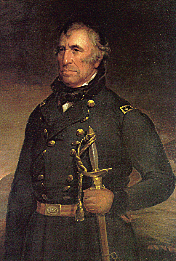
Few soldiers ever looked less "military" than Zachary Taylor.
Although he spent most of his life in the army, his preference for civilian
clothes became legendary. Those who saw him ride into battle wearing a straw
hat and an old coat nicknamed him "Old Rough and Ready."
Zachary Taylor was born on November 24, 1784, in Orange County, Virginia. When
Taylor was still a baby, his family moved to Kentucky, and he grew up on the
frontier. Following the lead of his father, who had been an officer in the
Revolutionary War, Taylor entered the army in 1811 and gradually rose up
through the ranks. He served in the War of 1812. He led American forces in the
Black Hawk War in 1832, and against the Seminole Indians in 1837.
In 1846, President Polk chose Taylor to command the forces protecting American
claims to Texas. During the Mexican War, Taylor's troops defeated Mexican
armies in battle after battle. His victories made him a national war hero.
President Polk soon believed that Taylor's new-found popularity made him
presidential material. Despite his lack of political experience, the Whigs did
indeed choose Taylor as their presidential candidate in 1848. Taylor defeated
both Lewis Cass, the Democratic candidate, and Martin Van Buren, the candidate
of the Free Soil party.
During Taylor's term, the slavery question dominated American politics.
President Taylor opposed the Compromise of 1850, a series of measures proposed
by Henry Clay and Stephen Douglas to deal with the issue. But Taylor's early
death made his opposition irrelevant.
On July 4, 1850, Taylor attended a ceremony at the unfinished Washington
Monument. It was a broiling hot day. After the ceremony, he returned to the
White House and ate several bowls of cherries and cucumbers washed down with
iced milk. The combination of the food and the heat made him acutely ill. Five
days later, he died.

All images of Presidents are courtesy of whitehouse.gov
Information taken from Software titled "American Heritage The History of
the United States for Young People.
The copyright belongs to: Forbes
Inc. and Byron Preiss Multimedia Company. Thank You!

Washington, Adams, Jefferson
Madison, Monroe, Adams
Jackson, Van Buren, Harrison
Tyler, Polk, Taylor
Fillmore, Pierce, Buchanan
Lincoln, Johnson, Grant
Hayes, Garfield, Arthur
Cleveland, Harrison, Cleveland
McKinley, T. Roosevelt, Taft
Wilson, Harding, Coolidge
Hoover, F. Roosevelt, Truman
Eisenhower, Kennedy, Johnson
Nixon, Ford, Carter
Reagan, Bush, Clinton
Bush, ????, ????
|

|
All graphics and
pages are copyright © 1997 - 2008 Pages 4 Ever
(except where noted). Do not take, copy, steal, plagiarize or use in any
way, shape or format without the express written permission of Pages
4 Ever.
Some backgrounds and graphics made from clipart acquired from ArtToday, Boxed Art,
friends, my own imagination, and/or
graphic CD collections that I have purchased. If you find anything on this site
that you have copyright to, and can prove it, please let me know and I will
gladly either remove it or place a link back to you, whichever you prefer.
If you should find any broken links, please drop us a line and let us know the
exact URL the broken link is on. Thank you.
|

|
![]()




